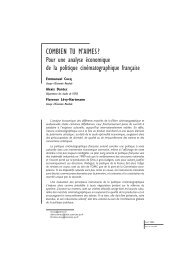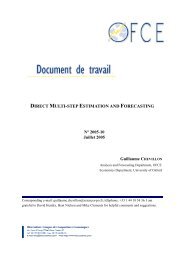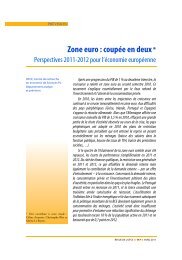N° 2005-09 Juin 2005 Guillaume Daudin* Jean-Luc Gaffard ...
N° 2005-09 Juin 2005 Guillaume Daudin* Jean-Luc Gaffard ...
N° 2005-09 Juin 2005 Guillaume Daudin* Jean-Luc Gaffard ...
Create successful ePaper yourself
Turn your PDF publications into a flip-book with our unique Google optimized e-Paper software.
Relocation: What Matters? Competition or/and a New Policy Mixexplanatory variables, economic density is not any more a determinant of labour productivity.On the other hand, while specialisation (indicating if the studied zone is specialized in a lownumber of sectors or if it offers a large range of activities) and specificity (here measured bythe difference between the sector structure of the zone and the structure of other zones in thecountry) have a strong positive effect on labour productivity, the effect of concentration is notso obvious. As economies that exhibit related diversification are also those showingsustainable growth and full employment, relatedness in the previous sense appears as themeans for avoiding relocation that would result from direct production costs differentials.As a matter of fact, these empirical results mainly confirm that the efficient variety isthe one that is associated with an innovation process successfully driven. It is also the one thatinvolved local demand or supply links. Thus, what matters is not really the existing variety ofgoods (and services), or the nature of clustering, but how it comes to the fore and evolves.When considering innovation as a process of creative destruction, the geographical dimensionof this process and the sector composition of local areas depend less on fundamentals than onthe conditions that make viable the process of change. Indeed, such a process inevitablygenerates both destruction and creation of productive capacities, in fact distortions in thetemporal structure of productive capacity that require adjustments to be carried out in time. Inthis perspective, competition is not only aimed at equalising supply and demand in a givenmarket and technological environment, but has also to adapt both structure and technology toopportunities created by expanding (or changing) markets. It should be viewed, not as a state(perfect competition), but as a process, which implies that market connexions (orimperfections) are essential means that make it possible to co-ordinate both competitive andcomplementary investments. In the latter perspective, public intervention cannot be reducedto create the conditions of enforcement of perfect competition rules (see Richardson 1960).As a matter of fact, technological development, which is effectively the way foradvanced countries to take advantage of the new division of labour by creating new varietiesof goods, is not only driven by incentives such as determined by given rules or institutions,but is based upon the ability of changing both local and global relations without creating toomuch perturbations. While new organisational structures for innovation result in part fromstrengthening linkages within territorial production complexes, innovation increasingly restsupon the primacy of extra-regional relationships. “Globalisation, in other words, presupposesa reconstruction of the spatial division of labour creating new forms of articulations betweenglobal and regional levels that move well beyond one-dimensional portraits of global‘footlooseness’ (in which the region is subsumed within a corporate division of labour,69








